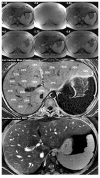Advances in pediatric nonalcoholic fatty liver disease
- PMID: 19637286
- PMCID: PMC2757471
- DOI: 10.1002/hep.23119
Advances in pediatric nonalcoholic fatty liver disease
Abstract
Nonalcoholic fatty liver disease (NAFLD) has emerged as the leading cause of chronic liver disease in children and adolescents in the United States. A two- to three-fold rise in the rates of obesity and overweight in children over the last two decades is probably responsible for the NAFLD epidemic. Emerging data suggest that children with nonalcoholic steatohepatitis (NASH) progress to cirrhosis, which may ultimately increase liver-related mortality. More worrisome is the recognition that cardiovascular risk and morbidity in children and adolescents are associated with fatty liver. Pediatric fatty liver disease often displays a histologic pattern distinct from that found in adults. Liver biopsy remains the gold standard for diagnosis of NASH. Noninvasive biomarkers are needed to identify individuals with progressive liver injury. Targeted therapies to improve liver histology and metabolic abnormalities associated with fatty liver are needed. Currently, randomized-controlled trials are underway in the pediatric population to define pharmacologic therapy for NAFLD.
Conclusion: Public health awareness and intervention are needed to promote healthy diet, exercise, and lifestyle modifications to prevent and reduce the burden of disease in the community.
Conflict of interest statement
Figures



References
-
- Shneider BL, Gonzalez-Peralta R, Roberts EA. Controversies in the management of pediatric liver disease: Hepatitis B, C and NAFLD: Summary of a single topic conference. Hepatology. 2006;44:1344–1354. - PubMed
-
- Matthiessen J, Velsing Groth M, Fagt S, Biltoft-Jensen A, Stockmarr A, Andersen JS, Trolle E. Prevalence and trends in overweight and obesity among children and adolescents in Denmark. Scand J Public Health. 2008;36:153–160. - PubMed
-
- Ji CY. The prevalence of childhood overweight/obesity and the epidemic changes in 1985-2000 for Chinese school-age children and adolescents. Obes Rev. 2008;9 1:78–81. - PubMed
-
- Ogden CL, Carroll MD, Curtin LR, McDowell MA, Tabak CJ, Flegal KM. Prevalence of overweight and obesity in the United States, 1999-2004. JAMA. 2006;295:1549–1555. - PubMed
-
- Schwimmer JB, Behling C, Newbury R, Deutsch R, Nievergelt C, Schork NJ, Lavine JE. Histopathology of pediatric nonalcoholic fatty liver disease. Hepatology. 2005;42:641–649. - PubMed
Publication types
MeSH terms
Grants and funding
LinkOut - more resources
Full Text Sources
Other Literature Sources
Medical
